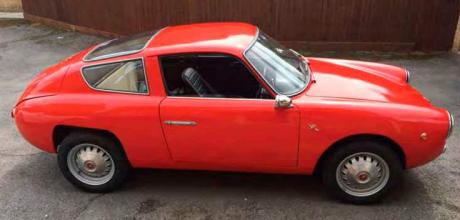1961 Abarth Monomille Coupe

From early days in school, I have been fascinated by the Abarth marque. Abarth was the first entry in my Observer’s Book of Automobiles and I was drawn to it almost hypnotically. The mother of my best friend at school had a Fiat-Abarth 595, and I remember thinking what a special little car that was. Whenever possible, I would persuade my father to stop for petrol at Anthony Crook’s Hersham Garage, which had the concession for Abarth, Bristol and Zagato-bodied cars in the late 1950s and ’60s. I would gaze longingly through the showroom window, dreaming that one day I might own one. Abarths were expensive little cars – the list price of the Monomille was £2430 against a Jaguar E-Type at £2200!
In 1979 I relocated to South Africa and, quite by chance, a friend came across an advert for a Renault Alconi engine and, almost as an afterthought, a Fiat-Abarth 1000 coupe. I couldn’t believe my eyes and phoned the seller, Graham Ashe, who had bought the car in a very sorry state with a Renault engine and gearbox fitted. It did indeed turn out to be a Monomille coupe. It was advertised at R2000 – about three times my monthly income – but with a loan the car passed into my ownership.
The body had been stripped of all paintwork and was down to bare aluminium, while the components were all packed in cardboard boxes. Graham had sourced a 903cc Fiat 850 Sport Coupe engine, bored out to 982cc, and an 850 transaxle. A borrowed trailer transported the car to Durban – a seven-hour trip. All went well until a wheel of the trailer detached itself but disaster was averted as the ensemble was brought to a grinding halt alongside a steep drop; the wheel was last seen bouncing into a banana plantation!
At the time I had been working on a car of my own design – an Alfa Romeo Giulietta Ti based special known as the Albinetta. Work on this ground to a halt as the Abarth took precedence. Detail inspection revealed that it had originally been painted bright blue, then yellow, but I preferred red as proper Italian sports cars should be. A friend arranged for the car to be sprayed in our garage but the undercoat didn’t dry properly, so the whole lot had to be taken back to bare metal again and reprimed before the top coat was applied.
Work on the car proceeded until 1983, when the purse strings had to be tightened, and progress was slow over the next 15 years. Then in 1998 we decided to return to the UK. Exporting the car to the UK involved a mountain of paperwork. In 2000, I had the idea of writing to Anthony Crook to see whether he could throw any light on the car’s early history, particularly as the car is right-hand drive. He replied with a hand-written note in red ink to the effect that it probably was sold by his dealership, and even included some anecdotes about Carlo Abarth.
Work recommenced in earnest in 2015 and in November 2017, the engine was fired up for the first time. Then began the ordeal of registering the car with an age-appropriate number – not a straightforward process. Providing proof of the date of manufacture was difficult, but I eventually obtained confirmation from Fiat Classiche that the chassis was built on 7 June 1961.
The end result is a very special car that has become part of me. I make no bones that it is not perfect. It has acquired a few minor ‘battle scars’, mainly caused by me against the very fragile Beccaris coachwork. I don’t feel I need to drive it to get a kick out of it; just looking at it gives me great pleasure. Its body lines are perfectly formed. It’s a very small car and I am rather large, so entry and egress are not elegant, resulting in one change: a smaller diameter Nardi wood-rimed steering wheel.

